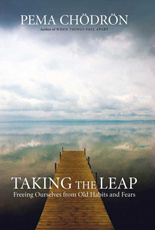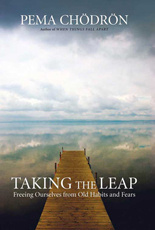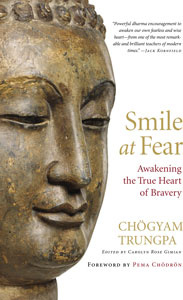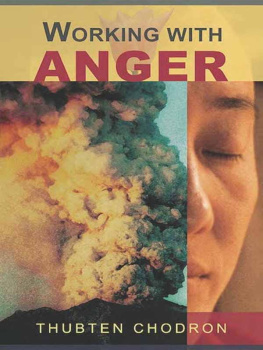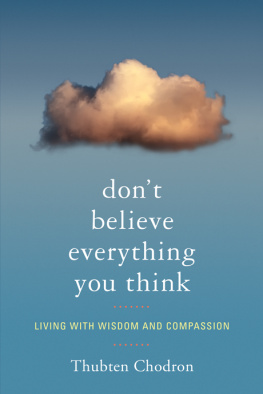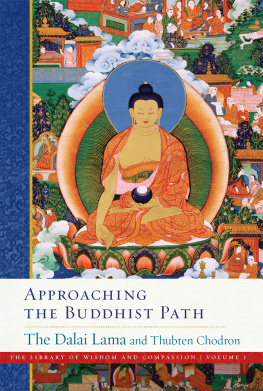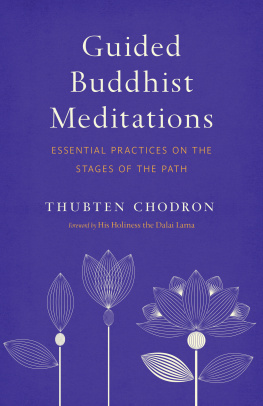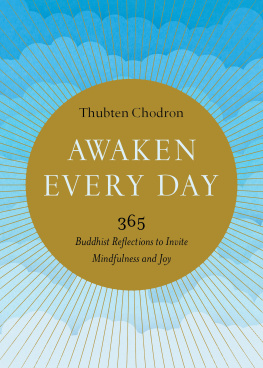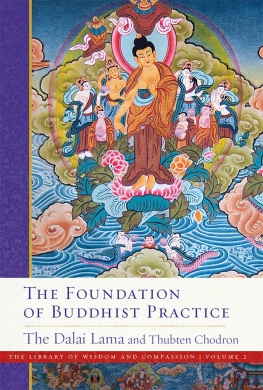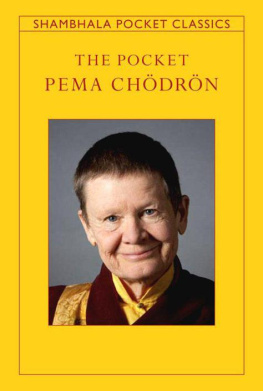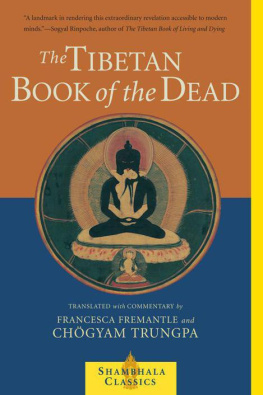Sign up to receive news and special offers from Shambhala Publications.

Or visit us online to sign up at shambhala.com/eshambhala.
Good Karma
HOW TO CREATE THE CAUSES OF HAPPINESS AND AVOID THE CAUSES OF SUFFERING
Thubten Chodron

SHAMBHALA
BOULDER
2016
Shambhala Publications, Inc.
4720 Walnut Street
Boulder, Colorado 80301
www.shambhala.com
2016 by Thubten Chodron
Cover art: Thinkstock Cover design by Gopa & Ted2, Inc.
All rights reserved. No part of this book may be reproduced in any form or by any means, electronic or mechanical, including photocopying, recording, or by any information storage and retrieval system, without permission in writing from the publisher.
Library of Congress Cataloging-in-Publication Data
Names: Thubten Chodron, 1950 author.
Title: Good karma: how to create the causes of happiness and avoid the causes of suffering / Thubten Chodron.
Description: First Edition. | Boulder: Shambhala, 2016.
Identifiers: LCCN 2015038921 | EISBN 9780834840263 | ISBN 9781611803396 (pbk.: alk. paper)
Subjects: LCSH: Religious lifeBuddhism. | HappinessReligious aspectsBuddhism. | SufferingReligious aspectsBuddhism.
Classification: LCC BQ4302 .T47 2016 | DDC 294.3/422dc23
LC record available at http://lccn.loc.gov/2015038921
For as long as space endures
And as long as sentient beings remain
Until then may I too abide
To dispel the miseries of the world
Shantideva, Engaging in the Bodhisattvas Deeds
May I be beloved of beings,
And may they be more beloved to me than myself.
May their bad deeds ripen upon me
And may all my virtue, without exception, ripen upon them.
Nagarjuna, Precious Garland
This book contains diacritics and special characters. If you encounter difficulty displaying these characters, please set your e-reader device to publisher defaults (if available) or to an alternate font.
E VERY BOOK HAS a story behind ithow and why it was written. Ill share part of that story with you now, and another part in the first chapter. From my own experience as a young Westerner encountering the Dharmathe Buddhas teachingsand my experience now many years later as someone introducing people to these teachings, its clear that the functioning of the law of karma (our actions) and its effects is both difficult and important to understand. In fact, its said that only a buddha completely knows the intricate details of how it works. People new to the Dharma, as well as people who have been practicing for decades (if not lifetimes), have questions about how karma works and how it applies to our lives. Fortunately, the Buddha and the great Buddhist masters that came after him have given us a wealth of material explaining karma and its effects that will give us the fundamental knowledge we need to create the causes of happiness and avoid the causes of suffering.
One of these kind masters is Dharmarakshita, the author of the poem The Wheel of Weapons Striking at the Vital Points of the Enemy, also called The Wheel of Sharp Weapons (Tib. blo-sbyong mtshon-cha khor-lo). This poem belongs to a genre of teachings in the Tibetan Buddhist tradition called thought training (lojong). These teachings help us train our mind to apply compassion and wisdom in our daily lives, especially to transform adversity into the path. They are immediately applicable to our lives, and when we practice them correctly, they reduce our anxiety, fear, and depression and replace them with wise acceptance, compassion for ourselves and others, determination to be free from cyclic existence (samsara) with its constantly recurring difficulties, and liberating wisdom.
This poem is attributed to the late-tenth-century Indian Buddhist sage Dharmarakshita, a teacher of the great Indian sage Atisha (9861054), who revitalized Buddhism in Tibet. Unfortunately, very little is known about Dharmarakshitas life. Some say he was a Vaibhika master; others say he was a great bodhisattva abbot. It is said that Atisha studied with him at the great Buddhist monastic university of Odantapuri in India.
The thought-training teachings in Tibet are traced to Atisha. From him they passed to the Kadampa geshes in Tibet and then down to the masters of the present day. I received this teaching from Geshe Ngawang Dhargye and Geshe Jampa Lodro, two of my most kind spiritual mentors.
OVERVIEW
Before actually embarking on Dharmarakshitas poem, its helpful to understand the Buddhist worldview: that we currently exist in a cycle of constantly recurring unsatisfactory experiences that is caused not by external people and objects, but by the ignorance, anger, and clinging attachment in our own minds. This is explained in chapter 2.
The third chapter, Brave Peacocks and Cowardly Crows, introduces us to Yamantaka (the fierce form of Majushr, the buddha of wisdom) and to bodhisattvas, those beings who aspire for full awakening for the benefit of all sentient beings. It contrasts these altruistic bodhisattvas with us ordinary beings, who focus primarily on our own well-being. The heart of the text begins with the fourth chapter, where Dharmarakshita presents us again and again with unpleasant situations we frequently encounter in life and tells us that these are not random occurrences or the fault of other living beings, but are in fact the result of our own self-centered actions. In doing so, he sparks us to realize that by changing our mental states and our actions, we have the power to learn from suffering and to change our experiences. In this way, we gain the power to transform difficulties into the path to full awakening. This continues in chapter 5, which contains ways to deal with sickness, laziness, and distractions, and in chapter 6, where we look at our spiritual obstacles and how to remedy them.
Chapter 7, Seize the Enemy: Identifying Self-Grasping Ignorance and the Self-Centered Attitude, identifies the real culprits, our self-centered thought and self-grasping ignorance. We learn how Yamantaka, the symbolic representation of clear wisdom and strong altruism, can help us dance and trample on these inner enemies. Chapters 8, 9, and 10 go into this in more depth, pointing out our mistaken behavior and ways of thinking and increasing our determination to abolish these through cultivating love, compassion, bodhicitta, and the wisdom realizing the ultimate nature.
Chapter 11, Safe at Last, speaks of the benefits of taking refuge in the Three Jewels and of building up our internal strength, as a prelude to chapter 12, which shows us the way to compassionate action and to becoming the person we want to be, a person unencumbered by self-centeredness and ignorance. This leads directly into chapter 13, which deals with the way to cultivate the wisdom realizing the emptiness of inheren existence and to understand that emptiness and dependent arising are complementary, not contradictory. Chapter 14 is the colophon and conclusion, with an inspiring poem by Atisha and the dedication. A section on recommended reading follows.
APPRECIATION
While working on this book, I received a request from a Dharma friend to write a book explaining the ins and outs of karma in detail. While the present volume does not go into the details found in the Abhidharma and stages-of-the-path literature about the various types of karma, their strengths, their results, and so forth, it does speak about karma in a most practical way. Dharmarakshita, in his directness, guides us to understand that our actions are not simply items in categories and numbered listswhich are definitely helpful to understandbut that we are creating karma and experiencing their results all day long. Karma is intertwined in the fabric of our life, and training ourselves to be aware of this can transform how we live. We become more mindful and thoughtful, making choices with care, understanding that our past actions, present experiences, and future circumstances originate in our minds.
Next page

